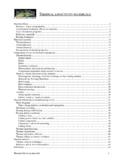Transcription of 5 - Cold Working Brass
1 Experiment 5 - Cold Work, Recovery, Recrystallization and Grain Growth Objective To study the effects of cold Working on the microstructure and mechanical properties of 70/30 Cartridge Brass . Background A small percentage of the energy expended in plastically deforming a material remains stored in the metal as an increase in internal energy. Changes are produced in both its physical and mechanical properties. Principally, there is a marked increase in hardness and electrical resistivity with the amount of cold Working . Microstructurally, this increment in internal energy is associated with an increase in the dislocation density as well as the density of point defects, such as vacancies and interstitials.
2 For most metals, the dislocation density increases from the values of 106-107 lines/cm2 (typical of the annealed state) to 108-109 after a few percent deformation and up to 1011 -1012 lines/cm2 after heavy deformation. At a more macrostructural level, the grains become markedly elongated in the direction of Working and heavily distorted. This distortion is evident from a bending of annealing twins and from unevenness in etching caused by local strain inhomogeneities. While the increased hardness and strength that result from the Working operation can be important, it is often necessary to return the metal to its initial condition by annealing.
3 This usually means holding the cold worked metal at a temperature above about 1/3 of the absolute melting point for a period of time. The annealing treatment is divided into three distinct regions: 1. Recovery: This usually occurs at low temperatures and involves motion and annihilation of point defects as well as annihilation and rearrangement of dislocations resulting in the formation of subgrains and subgrain boundaries ( , tilt and/or twist low-angle boundaries). A distinctive feature of the recovery process is that it does not involve any change in the grain structure of the cold-worked metal, the only changes taking place are the dislocation arrangements within the existing grains.
4 Small changes in hardness that are sometimes observed during recovery can be attributed to the decrease in the dislocation and point defect density and to the growth of the subgrains. 2. Recrystallization: If increased thermal activation is available ( , if the temperature is raised) nucleation and growth of strain-free grains in the deformed matrix will take place. As these grains grow, the dislocations in the matrix are annihilated at the boundaries of the newly-formed grains. Strength and hardness decrease considerably and ductility increases.
5 The lowest temperature at which stress-free grains appear in the structure of a previously plastically deformed metal is termed the recrystallization temperature. This depends upon the grain size, the severity of plastic deformation, and the presence of solute atoms or second phase particles. The recrystallization temperature is usually 1/3-1/2 the absolute melting point of the material. 3. Grain Growth: If a recrystallized material is further annealed at the same temperature or at a higher temperature grain growth usually occurs. Boundaries between annealed grains migrate and larger grains grow by an increase in the average grain size (or a decrease in the ASTM grain size number, n).
6 Grain growth depends on the fact that the grain boundary energy of the material is reduced due to the decrease in grain boundary area for a given volume of material. The effect of recovery, recrystallization and grain growth on grain size, internal stress and strength (or hardness) of a plastically deformed material is illustrated schematically in Figure 5-1. Measurement of Hardness Throughout this experiment, hardness measurements will be made using a Rockwell hardness tester. A 1/16" steel ball indentor with either a 60 or 100 kg load corresponds to the Rockwell F or Rockwell B scales.
7 Hardness value may be calculated from the load applied divided by the surface area of the indentation. However, the instrument you will use is calibrated to read hardness values directly. Consult with the instructor before operating the hardness tester. You should run a hardness test on the test standard for the particular scale being used before and after each set of measurements. At least three hardness measurements should be made on a smooth surface of each specimen to achieve statistical significance. If your hardness values fall below 20 or above 100, you need to change hardness scales.
8 Procedures You are provided with one rectangular strip of 70/30 Brass (Cartridge Brass ). The strip is fully annealed. On the fully-annealed strip (THICKER Brass sample), perform the following: 1. Measure the initial thickness and hardness 2. Reduce the thickness 50% by many small rolling steps. Make sure to measure the thickness and hardness after each pass through the rolling mill. Tighten the rolls only a small amount at each step or a safety pin will break. 3. Plot a curve of hardness vs. percent reduction in thickness. On the cold-rolled sample (flattened, slightly warped piece of Brass ), perform the following: 1.
9 Measure the hardness using Rockwell B scale 2. Cut the specimen into eight pieces about 1/2 in. long 3. Heat the eight pieces for 30 minutes at the following temperatures: specimen 1 2 3 4 5 6 7 8 Temperature C 250 300 350 400 500 600 700 reference Temperature F 480 570 660 750 930 1110 1290 After heating, quench the specimens in cold water.
10 4. Measure the hardness values of each of the eight specimens after the above heat treatment using the B scale. 5. Plot a curve of hardness vs. annealing temperature. Microstructural Investigation Grain size determination is described in Appendix F, which should be read at this point. You will be provided with a set of polished and etched samples at different aging temperatures. Examine these samples with the optical microscope noting grain size and shape. Determine quantitatively, the ASTM grain size number for the four highest annealing temperatures' samples.










